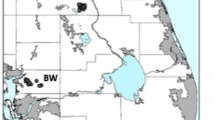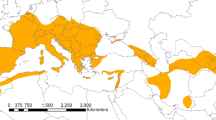Abstract
The Azorean bat (Nyctalus azoreum) is endemic to the Azores archipelago and is listed as endangered due to its reduced and fragmented distribution range. We assessed genetic diversity at eight microsatellite loci in 280 individuals from 14 locations throughout six islands. Overall, we found that the Azorean bat populations are not genetically impoverished. Indeed, the number of alleles per locus ranged from 8 to 10 and the observed heterozygosity ranged from 0.77 in Terceira to 0.83 in Faial. The highest genetic diversity and level of private alleles was observed in S. Miguel, the largest island, and the closest to the mainland. Private alleles occurred at all islands except in Graciosa. Global and pairwise F ST among islands were all statistically significant, suggesting restricted gene flow. These results, together with those of factorial correspondence analysis, Bayesian clustering method, and individual assignment tests, corroborate the conclusions of a previous mtDNA based study, providing strong support for the existence of two major subpopulations: one includes all islands of the Central Group and the other corresponds to S. Miguel. Gene flow between them is very limited, suggesting that management plans should avoid translocations between these subpopulations.


Similar content being viewed by others
References
Barcia AR, Espinosa G, Hernández D et al (2005) Temporal variation of the population structure and genetic diversity of Farfantepenaeus notialis assessed by allozyme loci. Mol Ecol 14:2933–2942
Belkhir K, Borsa P, Chikhi L et al (2004) genetix v. 4.05.2, logiciel sous WindowsTM pour la génétique des populations. Laboratoire Génome, Populations, Interactions CNRS UMR 5000, Université de Montpellier II, Montpellier
Birky CWJ, Fuerst PA, Maruyama T (1989) Organelle gene diversity under migration, mutation, and drift: equilibrium expectations, approach to equilibrium, effects of heteroplasmic cells, and comparison to nuclear genes. Genetics 121:613–627
Castella V, Ruedi M, Excoffier L (2001) Contrasted patterns of mitochondrial and nuclear structure among nursery colonies of the bat Myotis myotis. J Evol Biol 14:708–720
Corander J, Waldmann P, Sillanpaa MJ (2003) Bayesian analysis of genetic differentiation between populations. Genetics 163:367–374
Corander J, Waldmann P, Marttinen P et al (2004) BAPS 2: enhanced possibilities for the analysis of genetic population structure. Bioinformatics 20:2363–2369
Emerson BC (2002) Evolution on oceanic islands: molecular phylogenetic approaches to understanding pattern and process. Mol Ecol 11:951–966
Excoffier L, Smouse PE, Quattro JM (1992) Analysis of molecular variance inferred from metric distances among DNA haplotypes: Application to human mitochondrial DNA restriction data. Genetics 131:479–491
Excoffier L, Laval G, Schneider S (2005) arlequin (version 3.0): An integrated software package for population genetics data analysis. Evol Bioinform Online 1:47–50
Frankham R (1997) Do island populations have less genetic variation than mainland populations. Heredity 78:311–327
Frankham R (1998) Inbreeding and extinction: island populations. Conserv Biol 12:665–675
Frankham R (2003) Genetics and conservation biology. Comp Rendus Biol 326:22–29
Frankham R, Ballou JD, Briscoe DA (2002) Introduction to conservation genetics. University Press, Cambridge
Goldstein D, Schlötterer C (1999) Microsatellites: evolution and applications. Oxford University Press, Oxford
Goudet J (1995) fstat (Version 1.2): a computer program to calculate F-Statistics. J Heredity 86:485–486
Goudet J, Perrin N, Waser P (2002) Tests for sex-biased dispersal using bi-parentally inherited genetic markers. Mol Ecol 11:1103–1114
Greenwood PJ (1980) Mating systems, philopatry and dispersal in birds and mammals. Anim Behav 28:1140–1162
Guo SW, Thompson EA (1992) Performing the exact test of Hardy–Weinberg proportions for multiple alleles. Biometrics 48:361–372
Hardy OJ, Vekemans X (2002) spagedi: a versatile computer program to analyse spatial genetic structure at the individual or population levels. Mol Ecol Notes 2:618–620
Hardy OJ, Charbonnel N, Freville H et al (2003) Microsatellite allele sizes: a simple test to assess their significance on genetic differentiation. Genetics 163:1467–1482
Hedrick P (2005) A standardized genetic differentiation measure. Evolution 59:1633–1638
Hewitt GM (2001) Speciation, hybrid zones and phylogeography—or seeing genes in space and time. Mol Ecol 10:537–549
Hoezel AR, Halley J, O’Brien SJ et al (1993) Elephant seal genetic variation and the use of simulation models to investigate historical population bottlenecks. J Heredity 84:443–449
IUCN (2007) Nyctalus azoreum. In: European mammal assessment http://ec.europa.eu/environment/nature/conservation/species/ema/ Downloaded on 9 August 2007
Kerth G, Mayer F, Petit E (2002) Extreme sex-biased dispersal in the communally breeding, nonmigratory Bechstein’s bat (Myotis bechsteinii). Mol Ecol 11:1491–1498
Lawson Handley L, Perrin N (2007) Advances in our understanding of mammalian sex-biased dispersal. Mol Ecol 16:1559–1578
Liedloff A (1999) mantel v2.0: Mantel nonparametric test calculator. Queensland University of Technology, Brisbane
Manel S, Gaggiotti OE, Waples RS (2005) Assignment methods: matching biological questions techniques with appropriate. Trends Ecol Evol 20:136–142
Mathias ML, Ramalhinho MG, Santos-Reis M et al (1998) Mammals from the Azores islands (Portugal): an updated overview. Mammalia 62:397–407
Mayer F, Schlötterer C, Tautz D (2000) Polymorphic microsatellite loci in vespertilionid bats isolated from noctule bat Nyctalus noctula. Mol Ecol 9:2155–2234
Meirmans PG (2006) Using the AMOVA framework to estimate a standardized genetic differentiation measure. Evolution 60:2399–2402
Miller SA, Dykes DD, Polesky HF (1988) A simple salting procedure for extracting DNA from human nucleated cells. Nucleic Acids Res 16:215
Miller-Butterworth CM, Jacobs DS, Harley EH (2002) Isolation and characterization of highly polymorphic microsatellite loci in Schreibers’ long fingered bat, Miniopterus schreibersii (Chiroptera: Vespertilionidae). Mol Ecol Notes 2:139–141
Moore SS, Hale P, Byrne K (1998) NCAM: a polymorphic microsatellite locus conserved across eutherian mammal species. Anim Genet 29:33–36
Moritz C (1994) Defining “Evolutionary Significant Units” for conservation. Trends Ecol Evol 9:373–375
Paetkau D, Slade R, Burden M et al (2004) Genetic assignment methods for the direct, real-time estimation of migration rate: a simulation-based exploration of accuracy and power. Mol Ecol 13:55–65
Petit E, Mayer F (1999) Male dispersal in the noctule bat (Nyctalus noctula): where are the limits?. Proc R Soc Lond B 266:1717–1722
Petit E, Balloux F, Goudet J (2001) Sex-biased dispersal in a migratory bat: a characterization using sex-specific demographic parameters. Evolution 55:635–640
Petri B, Pääbo S, von Haeseler A et al (1997) Paternity assessment and population subdivision in a natural population of the larger mouse-eared bat Myotis myotis. Mol Ecol 6:235–242
Piry S, Alapetite A, Cornuet J-M et al (2004) geneclass 2: a software for genetic assignment and first-generation migrant detection. J Heredity 95:536–539
Queiroz AI, Alves PC, Barroso I et al (2006) Nyctalus azoreum Morcego dos Açores. In: Cabral MJ, Almeida J, Almeida PR et al (eds) Livro Vermelho dos Vertebrados de Portugal. Instituto da Conservação da Natureza/Assírio & Alvim, Lisboa, pp 463–464
Rainho A, Marques JT, Palmeirim JM (2002) Os morcegos dos arquipélagos dos Açores e da Madeira: um contributo para a sua conservação. Instituto da Conservação da Natureza, Lisboa
Rannala B, Mountain JL (1997) Detecting immigration by using multilocus genotypes. Proc Natl Acad Sci USA 94:9197–9201
Reed DH, Frankham R (2003) Correlation between fitness and genetic diversity. Conserv Biol 17:230–237
Rice WR (1989) Analysis tables of statistical tests. Evolution 43:223–225
Rivers NM, Butlin RK, Altringham JD (2005) Genetic population structure of Natterer’s bats explained by mating at swarming sites and philopatry. Mol Ecol 14:4299–4312
Ruedi M, Castella V (2003) Genetic consequences of the ice ages on nurseries of the bat Myotis myotis: a mitochondrial and nuclear survey. Mol Ecol 12:1527–1540
Salgueiro P, Coelho MM, Palmeirim JM et al (2004) Mitochondrial DNA variation and population structure of the island endemic Azorean bat (Nyctalus azoreum). Mol Ecol 13:3357–3366
Salgueiro P, Ruedi M, Coelho M et al (2007) Genetic divergence and phylogeography in the genus Nyctalus (Mammalia, Chiroptera): implications for population history of the insular bat Nyctalus azoreum. Genetica 130:169–181
Skiba R (2003) Azorenabendsengler—Nyctalus azoreum (Thomas 1901). In: Europäische Fledermäuse: Kennzeichen, Echoortung und Detektoranwendung. Westarp Wissenschaften, Hohenwarsleben, pp 136–137
Slatkin M (1985) Rare alleles as indicators of gene flow. Evolution 39:53–65
Slatkin M, Excoffier L (1996) Testing for linkage disequilibrium in genotypic data using the Expectation-Maximization algorithm. Heredity 76:377–383
Templeton AR, Routman E, Phillips CA (1995) Separating population structure from population history: a cladistic analysis of the geographical distribution of mitochondrial DNA haplotypes in the tiger salamander, Ambystoma tigrinum. Genetics 140:767–782
Thomas O (1901) On some new African bats. Ann Mag Nat Hist 7:34
Veith M, Beer N, Kiefer A et al (2004) The role of swarming sites for maintaining gene flow in the brown long-eared bat (Plecotus auritus). Heredity 93:342–349
Wilcox B (1980) Insular ecology and conservation. In: Soulé M, Wilcox B (eds) Conservation biology: an evolutionary ecological perspective. Sinauer, Sunderland, MA, pp 95–117
Wildt DE, Bush M, Goodrowe KL et al (1987) Reproductive and genetic consequences of founding isolated lion populations. Nature 329:328–331
Worthington Wilmer J, Barratt EM (1996) A non-lethal method of tissue sampling for genetic studies of chiropterans. Bat Res News 37:1–4
Worthington Wilmer J, Hall L, Barratt EM et al (1999) Genetic structure and male-mediated gene flow in the ghost bat (Macroderma gigas). Evolution 53:1582–1591
Acknowledgements
We are indebted to the people who helped during field work: Ana Cerveira, Filipe Moniz, Mafalda Frade, Filipe Canário, Mário Silva, Helder Fraga, Fernando Pereira, and Margarida Leonardo. We are grateful to Maria José Pitta and André Silva from the Direcção Regional de Ambiente dos Açores for processing the permit to handle bats. Finally, we would like to thank Eric Petit for advice, and Michael Schwartz and two anonymous reviewers for suggestions that improved the manuscript. This research was funded by Fundação para a Ciência e Tecnologia (project POCTI: BSE/33963/99-00), and a PhD grant to P.S. (SFRH/BD/1201/2000), co-financed by the European Regional Development Fund.
Author information
Authors and Affiliations
Corresponding author
Electronic supplementary material
Below is the link to the electronic supplementary material.
Rights and permissions
About this article
Cite this article
Salgueiro, P., Palmeirim, J.M., Ruedi, M. et al. Gene flow and population structure of the endemic Azorean bat (Nyctalus azoreum) based on microsatellites: implications for conservation. Conserv Genet 9, 1163–1171 (2008). https://doi.org/10.1007/s10592-007-9430-z
Received:
Accepted:
Published:
Issue Date:
DOI: https://doi.org/10.1007/s10592-007-9430-z




